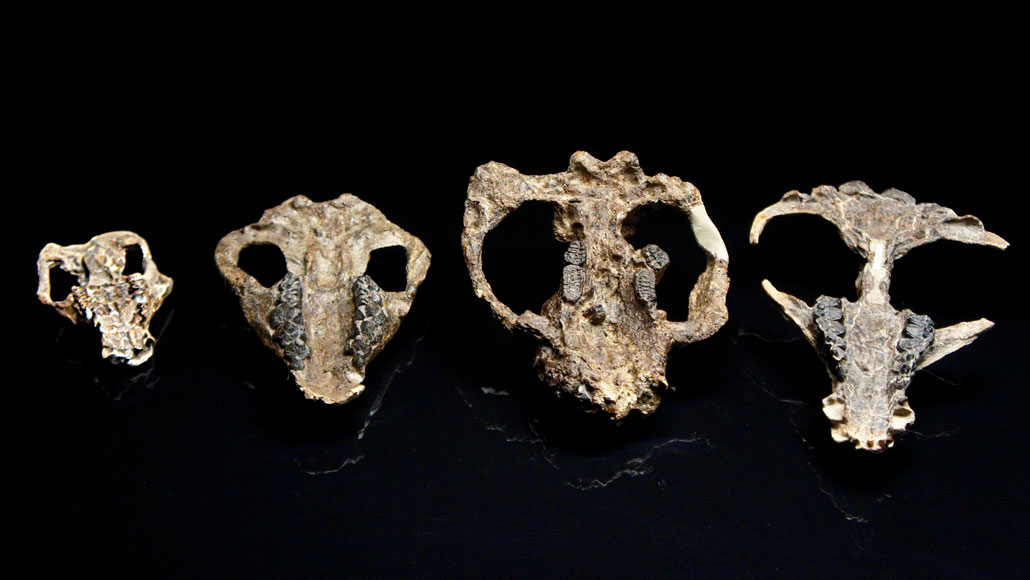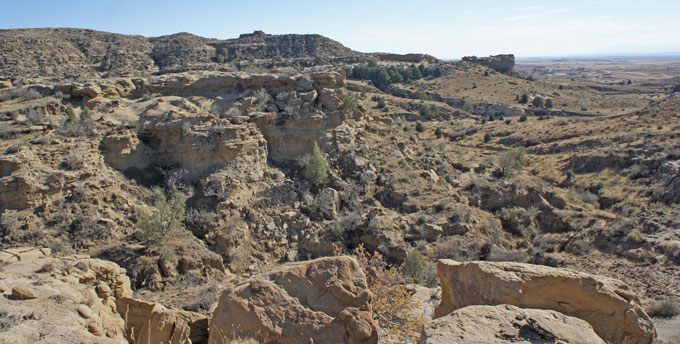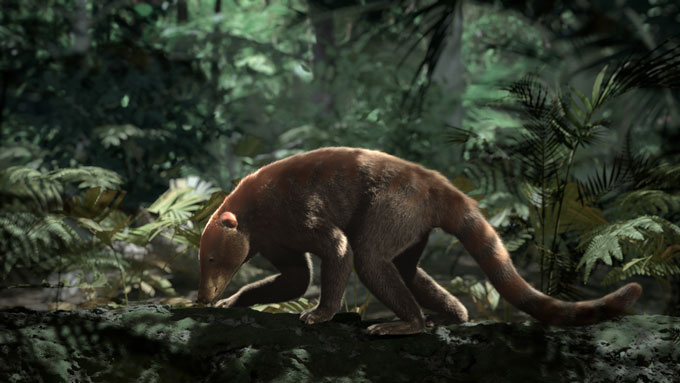Fossils show mammals’ rise to dominance after the dino-killing asteroid
Within 700,000 years, some rat-size survivors grew to be as big as a wolf

Scientists found 40 mammal skulls (some shown) at a site in Colorado. The fossils show how mammals thrived after an asteroid strike 66 million years ago.
HHMI TANGLED BANK STUDIOS
Share this:
- Share via email (Opens in new window) Email
- Click to share on Facebook (Opens in new window) Facebook
- Click to share on X (Opens in new window) X
- Click to share on Pinterest (Opens in new window) Pinterest
- Click to share on Reddit (Opens in new window) Reddit
- Share to Google Classroom (Opens in new window) Google Classroom
- Click to print (Opens in new window) Print
Some 66 million years ago, an asteroid wiped out up to 75 percent of Earth’s species. This marked the end of the dinosaurs, but certainly not all life died. Understanding how those survivors fared has been hard. After all, few fossils exist from right after the cataclysm. But one unexpected trove has now turned up in Colorado’s Denver Basin. These fossils offer scientists a glimpse into how mammals, plants and reptiles ultimately came to flourish.
“This is one of those discoveries all paleontologists dream of,” says Steve Brusatte, a paleontologist at the University of Edinburgh in Scotland who was not involved in the research. “With a snap of a finger, mammals took over from the dinosaurs. More than 150 million years of dinosaur dominance was ended, just like that, and our ancestors took over.”
The Corral Bluffs site in the Denver Basin is the only known locality in the world to have numerous fossils of animals and plants representing a whole series of time slices in the 1 million years following the Cretaceous–Paleogene, or K–Pg, extinction.
Over the last three years, a team led by researchers at the Denver Museum of Nature and Science has uncovered more than 7,000 fossils there. These include 233 kinds of plants and 16 species of mammals — among which are the earliest known mammals to reach relatively large sizes as they evolved and filled ecological roles previously occupied by dinosaurs.

The newfound fossils also helped scientists build a detailed timeline of how mammals quickly diversified and grew in size. Within 700,000 years, for instance, some mammals had grown to be 100 times as big as the original survivors.
Researchers described the new fossils online October 24 in Science.
Long overlooked
Fossil hunters had not ignored the Corral Bluffs site. Indeed, they spent the last century scrounging for fossils there. Yet few fossils turned up — until paleontologist Tyler Lyson realized he had been looking in the wrong place. In 2016, he began focusing on nodules of rock, called concretions (Kon-KREE-shuns). He found lots of fossils inside them, not scattered among surface rocks.
Says Lyson, “That was the real game-changing moment when I broke open the first concretion and saw a mammal skull staring back at me.”
By comparing plant and animal fossils with data on precise dates for the rocks, the researchers puzzled together what happened at Corral Bluffs 65 million to 66 million years ago. Following global devastation caused by the asteroid impact, ferns and palms dominated quickly came to dominate. Slowly, forests with a much greater diversity of trees replaced them.
Mammals took a little while to recover. But in time they swiftly diversified into a variety of forms and sizes. About the size of a rat, the biggest initial survivors of the impact weighed just 500 grams (1.1 pounds). But rock from 100,000 years later hosts fossils of raccoon-sized mammals that would have weighed up to 6 kilograms (13.2 pounds), Lyson says. That’s not far from biggest mammals that existed before the mass extinction.
By 300,000 years after the impact, some mammals were now 25 to 30 kilograms (55 to 66 pounds). This included the beaver-sized Carsioptychus. What led to that growth in their size? A lack of large predators in the post-impact world have helped. So would an explosion in plant diversity, which would have given them a wider array of dining choices.

By 700,000 years after the mass extinction, these rock deposits held fossils of the earliest known members of the legume, or bean, family. Mammals also appeared weighing nearly 50 kilograms (110 pounds), such as the wolf-size Eoconodon.
The sheer number of fossils and different time slices revealed at Corral Bluffs, astound Brusatte, in Edinburgh. So did the number of mammal skulls — at least 40 so far. Skulls are usually very rare. In fact, mammals from around this time are typically “known just from teeth, and maybe a few bones here and there,” he says.
Brusatte is working on a related site in New Mexico. It is among the very few others with similarly aged vertebrate fossils. Though those fossils are less complete, they too point to a rapid recovery and diversification of mammals after the impact. “Different areas are giving the same signal,” he says. “That tells us that it’s probably true.”
Many mammals before the impact were very different from those today. For instance, so-called “placental” mammals came to dominate. These are animals whose young develops in a womb. Today, they account for some 95 percent of the roughly 6,500 mammal species alive.
Corral Bluffs “is the best record” showing how land-based ecosystems recovered from the K–Pg extinction, says Jin Meng. He’s a paleontologist and expert on dinosaur-era mammals at the American Museum of Natural History in New York City. The newfound fossils show “at least part of the earliest record — part of the trunk — of the placental mammal tree of life.”







